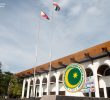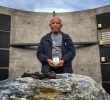By AMIRAH ALI LIDASAN
What seems to be the �significant victory� in the recent raid by the Armed Forces of the Philippines against the Abu Sayyaf at the pre-dawn hours of August 12, 2009?
Was this military raid a show for Admiral Timothy Keating, the commander of the US Pacific Command (USPACOM), who arrived in Manila on Tuesday onboard the USS George Washington aircraft carrier for the regular RP-US Mutual Defense Board (MDB) and Security Engagement Board (SEB) meetings?
For Western Mindanao Command chief Maj. Gen. Ben Dolorfino, the recent military operation was a significant victory despite the military losses: 23 soldiers dead and 22 others wounded.
What is victorious about it, he said, is that they were able to overrun an Abu Sayyaf camp in Basilan which is said to be their training camp for bomb-making. They also killed at least 21 Abu Sayyaf men.
Army spokesperson Lt. Col. Arnulfo Burgos Jr. gave a higher count: between 30 and 40 Abu Sayyaf men killed, while in another broadsheet, Navy spokesman Lt. Col. Edgard Arevalo said the number of Abu Sayyaf men killed was 31.
The marines, army and navy forces were all part of the Task Force Trillium, led by the commander of the Naval Forces in Western Mindanao Rear Admiral Alexander Pama.
According to Dolorfino, the offensives had two waves, the first one consisted of Special Operations Command (Scout Rangers), the 61st Marine Company, Force Recon Battalion, the Special Operations Platoon 10 and the Marine Battalion Landing Team 10. The second wave involved soldiers from the 67th Marine Raider Company, the Force Recon Battalion and the police Special Action Force.
More or less there were 400 soldiers in that raid aiming to subdue 50 Abu Sayyaf men in a so-called bomb-making training camp in Sitio Kurrelem, Barangay Silangkum in Tipo-Tipo. A wounded soldier even reported that during their 18-hour long battle, the Abu Sayyaf men swelled to 150 fighters. The increase in the Abu Sayyaf numbers, as explained by Dolorfino, was due to the participation of members of the Moro Islamic Liberation Front (MILF) who became �part-time� Abu Sayyaf men during that clash.
This is the part where the story became absurd. Most of those who worked hard for the resumption of peace negotiations between the Government of the Republic of the Philippines and the MILF would cry foul on this story and would want the government to clarify the purpose of their recent attack in Basilan.
In the MILF website, www.luwaran.com , MILF spokesperson Eid Kabalu said that they lost 10 of their men in the firefight because of the tactic made by the marines during the raid. The raid started at 3 am in Sitio Kurrelem. At 6 am, the Marines �diverted its offensives against MILF forces under the 114th Base Command of the Bangsamoro Islamic Armed Forces (BIAF)-MILF� at the adjacent Sitio Kapayagan, Barangay Baguindan in Tipo-Tipo. Baguindan is a known MILF base in Basilan. It is also the home of Ustadz Hamsa Sapanton, MILF provincial committee chairman, and some brigade commanders.
This was probably the reason why the numbers of the Abu Sayyaf increased, as told by the soldiers. The military switched areas in their operations and for the rest of the day was fighting the 114th Base Command of the BIAF-MILF.
In the luwaran website, the MILF accused the military of �violating the existing MILF � government ceasefire accord� and to have �diminished the letter and spirit of President Gloria Macapagal-Arroyo�s declaration of suspension of military offensives (SOMO) in conflict areas against MILF forces in a bid to resume the stalled peace negotiations with the MILF.� MILF further said they would file a protest against the government.
Reports of Abu Sayyaf casualties in exchange of US military aid
We all first had our knowledge of the towns of Tipo-Tipo, Ungkaya Pukan and Albarka in Basilan in July 2007 when the Philippine Marines raided an �Abu Sayyaf camp� in Albarka, Basilan purportedly to rescue Italian priest Father Giancarlo Bossi. The Abu Sayyaf kidnapped Bossi and reportedly kept him in Albarka, Basilan. Father Bossi was kidnapped in Sibugay province and was months later released in Lanao del Norte, hours and kilometers away from Basilan province.
Fact-finding missions, investigations and ceasefire monitoring reports showed that the Philippine Marines� raid in July 2007 turned out to be a violation of the GRP-MILF ceasefire agreement. The area in Albarka was a base camp of the 114th MILF-BIAF led by Asid Salih.
WestminCom Chief Dolorfino identified the same Asid Salih as one of the slain �Abu Sayyaf� in the recent Task Force Trillium raid in the town of Tipo-Tipo.
People who have lived and worked as government employees or non-government workers in Basilan for many years can differentiate an ordinary kidnapper from an Abu Sayyaf; and an Abu Sayyaf camp from an MILF camp.
Baguindan village in Tipo-Tipo is a known MILF camp. In Basilan, Baguindan is where most of the development projects facilitated by the Bangsamoro Development Agency and the Philippine government for relief and rehabilitation are concentrated.
Former secretary of the Office of Presidential Adviser on the Peace Process Hermogenes Esperon Jr. said Baguindan is among the first to complete last year the community and training center as subprojects for the Mindanao Trust Fund � Reconstruction and Development Program.
In the project, Baguindan has been identified as the center for the whole Zambasulta region (Zamboanga, Basilan, Sulu, and Tawi-Tawi).
What is confusing is that everytime there is a raid, the government would always report that they have annihilated the Abu Sayyaf. Yet when there is an American envoy visiting the country or when President Arroyo is scheduled to visit the United States to talk on arms deal and military aid for the Philippines, the Abu Sayyaf comes into being.
The higher the number of reported dead Abu Sayyaf, the higher the number of US military arsenals and the amount of funds for the Philippines.
It was suspicious why the raid consisting of more than 400 soldiers was timed during the visit of Admiral Keating just as the mysterious bombings in Mindanao happened in time of US Central Intelligence Agency (CIA) chief Leon Panetta�s meeting with President Gloria Macapagal-Arroyo on June 12.
One of the outputs in Admiral Keating�s meeting has been the US government�s pledge to help set up radar stations in Mindanao under the guise of continuing US-RP partnership against terror. The US government would support the �coast watch south� project, which entails setting up of radar stations in the Sulu, Basilan, Tawi-tawi archipelago and the eastern part of Mindanao. This is an added feature for the permanent basing of the US military forces in Mindanao.
So despite our protests against the Visiting Forces Agreement and the entry of US arsenal in our country, US troops are here to stay.
In an abs-cbnnews.com report, former US ambassador to the Philippines and the first Director of National Intelligence of the US John Negroponte said that the terror threat has diminished in Mindanao. But US troops are staying because the Philippines wants them here.
Buried in the protests against President Arroyo�s lavish dinners in New York during her recent US visit is the story on existing US and Philippine relations: What has US President Barrack Obama asked from Arroyo and what has Arroyo dutifully promised Obama?
On July 23 this year, or a week before her scheduled visit to the US, President Arroyo called for a suspension of military operations or SOMO against the MILF. Two days later, the MILF called for the suspension of military action against the AFP.
This gesture by President Arroyo was rewarded by President Obama with a pat on the back. Obama praised Arroyo for �initiating a reconciliation process in troubled Mindanao that the US think has the potential to bring peace and stability in the Philippines.� Meaning? US military presence will continue in the Philippines.
Now it�s not only the permanent presence of US troops, but also the permanent presence of their aircraft carriers such as the USS George Washington and USS Reagan under the guise of humanitarian services and military exercises.
Together with several USAID projects pouring in conflict areas and post-conflict areas in Mindanao, the US troops and US radars would definitely form a US base in the entire Mindanao Island, where US economic interest is placed.
Aside from fruit and rubber plantations, US-based companies have also set their eyes in conquering the Sulu Sea Basin for oil exploration and Liguasan Marsh in Central Mindanao for natural gas exploration.
Sincerity to Peace Talks is needed in Mindanao
So, for whom and for what is the government�s call for the resumption of peace negotiation with the MILF? For whom is the �peace and stability� promised by President Arroyo to Obama or vice-versa?
In the joint statement of the GRP and the MILF on the SOMO and SOMA on July 29 in Kuala Lumpur, the GRP �took serious note of the concern of the MILF on the implication of the exclusion from the SOMO of some MILF commanders tagged as �rogues� by the government.�
It should, because the reason why there are more than 300,000 evacuees in Central and Far Southern Mindanao is because of the military offensives against Commanders Abdullah �Bravo� Macapaar, Ustadz Ameril Ombra Kato and Ustadz Solaiman Pangalian.
The Norwegian Refugee Council’s Internal Displacement Monitoring Centre even estimated 600,000 evacuees because of the fighting, placing Mindanao among the places in the world with the highest number of refugees.
The exclusion of the �rogue� MILF leader meant that military operations will continue in Maguindanao, North Cotabato, Lanao del Norte and Lanao del Sur, Basilan and Saranggani — the same provinces affected in last year�s military operations. Hence, there is no guarantee for the safety of the evacuees once they concede to the call of the government to return to their communities.
And how can they come back to their communities when bombings continue?
On August 6, 2009, an evacuation center in Barangay Macasendeg in Pikit, North Cotabato and a mosque at Reina Regente in Datu Piang, Maguindanao were reportedly hit by 105mm mortar allegedly by elements of the military.
This incident adds to the number of reported cases of human rights violations committed by the AFP against Moro civilians in the course of their military actions against the Moro Islamic Liberation Front. What is lamentable is that in all the reported violations, the AFP denies their involvement or even justifies the attack as a legitimate military operation, hence making it difficult for the victims to ask for indemnification.
No soldier nor unit of the AFP was punished for the massacre of eight (8) Moro civilians, including women and children as a result of the Philippine Airforce air raid in Barangays Tee Datu Piang on September 13 last year. Despite the numerous fact-finding missions, and the result of the Commission on Human Right�s investigation, the AFP has not been made accountable to the crime.
Hence, the Moro people are suspicious of the GRP�s intention behind the resumption of the peace negotiation with the MILF. The resumption of the peace negotiation should also tackle the numerous human rights violation cases committed by the AFP against Moro civilians. Justice should be given to the victims. The government�s incessant attacks on Moro communities will not stop until the criminal tag against the MILF commanders are lifted, or until the government stops linking the MILF with the Abu Sayyaf or treating Moro communities as havens of terror.
Our last year�s experience with the non-recognition of the MOA-AD shows how difficult it is for the Moro people to ensure that their right to their land would be recognized. Should the peace talks resume and the MOA-AD signed, our struggle would be on how to protect the Bangsamoro homeland from the claws of the US government. (Amirah Lidasan is the national president of the partylist Suara Bangsamoro)










